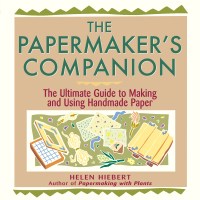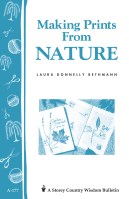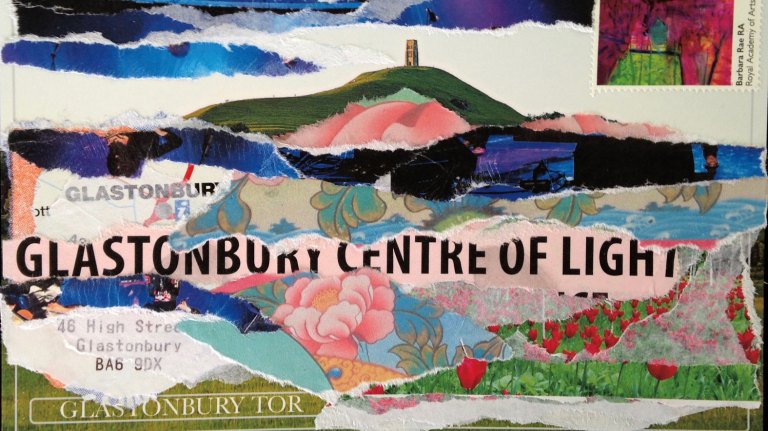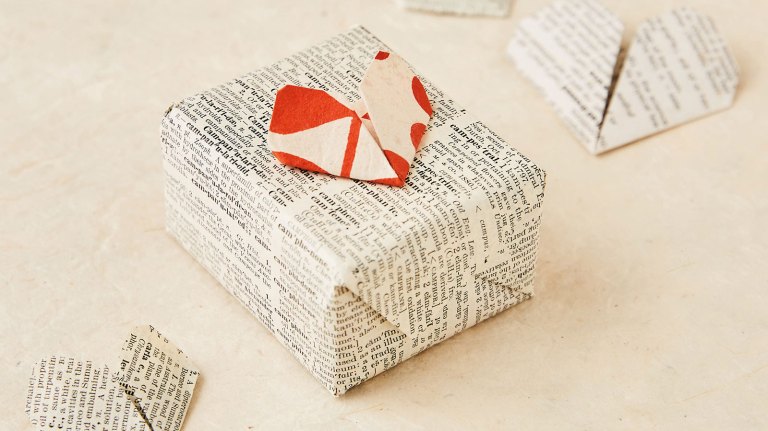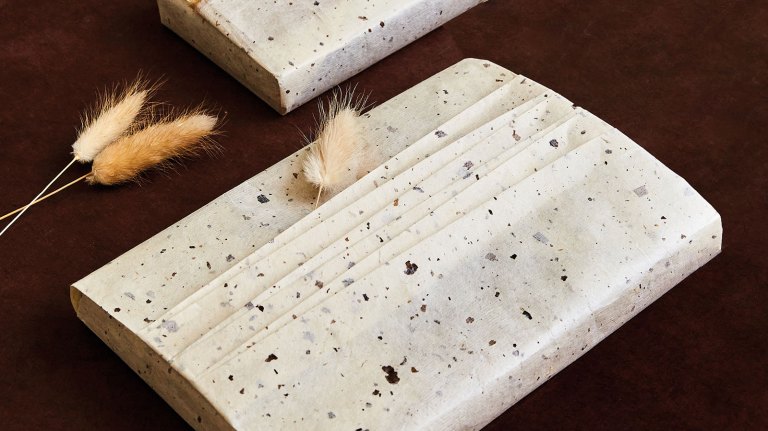Project: Shadow Lantern
While electric lights of the holidays are lovely, there is something truly special about candles glowing softly through paper. Few know this better than paper artist and author Helen Hiebert. If you love candlelight this time of year, give this shadow lantern project from Helen’s book, Paper Illuminated, a try.
Still looking for a holiday gift idea? Helen has created three different Shadow Lantern Kits. Each kit makes one of three patterns (Star, Snowflake, and Celtic Knot), pictured below, and contains most of the necessary supplies. Visit her shop for full details.
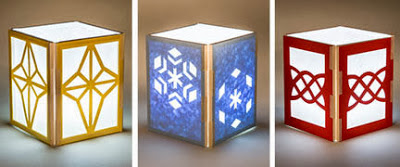
I love this time of year. The days grow shorter, fires crackle, holiday lights sparkle, and candles glow. Paper and light combine the functional with the decorative. Paper can be illuminated with candlelight, natural light, and incandescent light. In each case, paper diffuses the harshness of the light, giving it a warm, soft glow. In return, the light enhances the paper, displaying the delicate and subtle textures, colors, designs, and variations in opacity.
As the winter solstice approaches, why not make a little more light? I designed these Shadow Lanterns after a brief trip to Japan, where I was inspired by the light that filtered through the traditional paper shoji screen room dividers in the Japanese inn where I was staying. I published the original project in my book, Paper Illuminated, which features 15 projects for making handcrafted luminaria, lanterns, screens, lampshades, and window treatments.
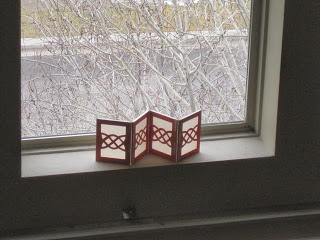
Shoji screen panels are generally rectangular, and in a twist on tradition, I added shapes and curves, which is so easy to do with paper. And although this structure might look complex, it is simply a series of paper panels that are held rigid with strips of balsa wood glued between sheets of paper (no wood joinery)!
The hinge that connects the panels is amazingly versatile, making the lantern reversible (you can turn it inside out). You can also unfold it to display it as a folding screen or even fold it into a book.
The possibilities for cut-outs are endless. I love making things and I enjoy the design work as much creating with my hands. I’ve had so much fun designing these Shadow Lantern kits. Whether you use the kit or create lanterns of your own, I hope you’ll find joy in making, gifting, and illuminating them!
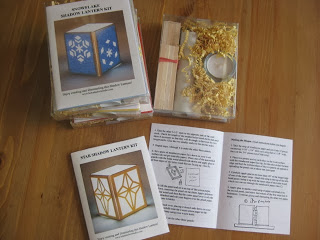
Shadow Lantern
Selecting the Paper
The stencil paper for this project should be a card-weight stock that can be cut with a craft knife. The screen paper should be semi-translucent, so that the shadow cast by the candle inside will be visible.
Materials
- Carbon paper or photocopy machine
- Small piece of card stock
- Craft knife
- Stencil paper: 4 pieces of 4½- x 6-inch card stock
- Cutting mat
- Straight edge
- Screen paper: 4 pieces of 5½ x 7-inch semi-translucent paper
- 8 pieces of ¼-inch-square strips of balsa wood, cut to 4 inches in length
- 8 pieces of ¼-inch square strips of balsa wood, 6 inches in length
- Small saw (a Japanese or jeweler’s saw works well)
- Sandpaper
- White glue
- Acrylic paint (optional)
- Hinge strips: 4 strips of 6- x ½-inch paper (to make a lantern) OR 3 strips of 6- x ¾-inch paper (to make a screen), cut out of either the matching screen paper or another strong, thin paper
Making a stencil design
1. To start this project, you will need to design a pattern. Textile designs, tile patterns, and architectural details are great sources of inspiration. There are many copyright-free clip-art books full of interesting designs and patterns. Of course, you can work freehand and just draw your own design.
2. Once you choose a design, trace it or use a photocopy machine to enlarge, reduce, or repeat patterns to create a 3½-inch by 5½-inch image area (your pattern should have at least a solid ¼-inch border all around). The cutouts should be at least ¼ inch in width in order to cast a shadow when the lantern is illuminated.
Making a pattern
1. Your lantern can have the same design on all four sides, or you can create four different patterns. If you use the same design on all four sides, it is useful to create a pattern. Make the pattern 4½ inches by 6 inches—the same size that your finished panels will be.
2. Using carbon paper, trace the design onto a piece of card stock (you can also photocopy the design directly onto the card stock, if you prefer). Use a craft knife to cut out the pattern.
3. Trace the pattern(s) onto the four stencil panels. Working on a cutting mat and using a straight edge and a craft knife, cut out the design (figure 1). Depending on the thickness of the card stock, you may be able to layer two or more pieces and cut them at the same time.
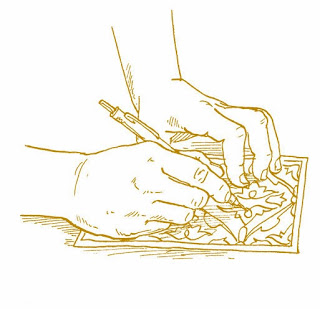
Creating the panels
1. Start with one stencil panel (card stock with cutouts) and two 4-inch and two 6-inch lengths of balsa wood. Note: Most balsa wood has the printing or paint on the ends for retail sales purposes. These features may show in your final product, so I recommend either cutting them off with a small saw or using sandpaper to remove them.
2. Apply glue to one side of a 6-inch strip of balsa wood and place it glue-side down onto one edge of the stencil (figure 2). (If there are pencil marks on your stencil, glue the balsa wood to that side—the marks will not be visible on the final piece.)
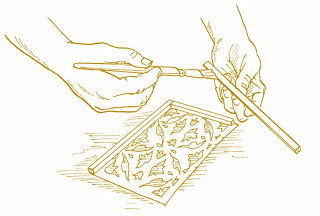
3. Glue the other three strips of balsa wood to the outer edges of the stencil panel. I don’t apply glue to the corner joints of the wood on lanterns this small. Repeat steps 1 through 3 to make the other three panels.
Gluing tip
Always put adhesive on the object you are gluing. Apply adhesive to the entire surface and, if it is a piece of paper, glue “out” onto a piece of scrap paper so that you spread the glue all the way to the very edges (see below). Keep a damp paper towel nearby to clean off your fingers, since they may
get a little sticky. This will keep excess glue from getting on the surface of your materials.
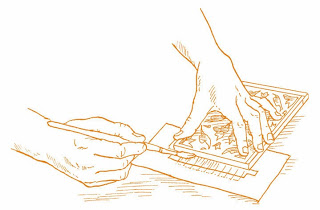
Attaching the screen paper
1. Use the template (figure 3) as a guide to cut out the four screen papers. Be sure to cut the small slits at each corner.
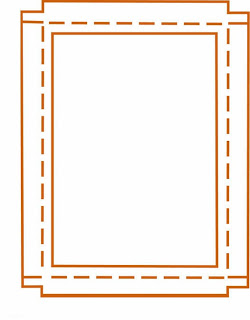
2. Set a piece of screen paper face down on your work surface. Place one of the assembled panels with balsa wood stencil-side down and apply glue to the edges of the balsa wood that are facing up.
3. Carefully lift the panel and set it on top of the screen paper, glue-side down, centering the panel on the sheet, making sure the corners line up with the inside ends of the slits (figure 4). Flip the entire panel over (with the screen paper attached) and rub your fingers over the glued paper, smoothing out any wrinkles.
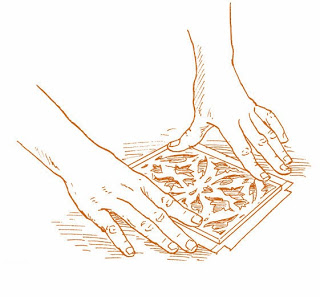
4. Turn the panel back over and apply glue to the excess paper on one of the short sides. Fold it up and over the balsa wood, neatly covering the side and top edges (figure 5). Fold the two small tabs over onto the adjacent sides of the panel. Repeat this step on the opposite short side.
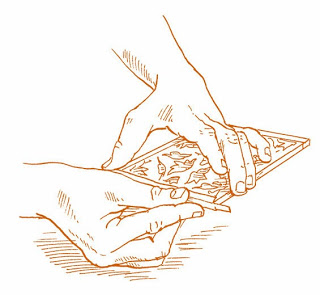
5. Apply glue to the excess paper on one of the long sides and wrap the paper over the side and top edges of the balsa wood, covering the tabs. Repeat this step on the other long side.
6. Repeat steps 1 through 5 to create the other three panels.
Making hinges for a lantern
Follow these instructions if you wish to make a lantern. If you prefer to make a folding screen, skip to Variation: Making a Screen at the end of these directions.
Materials
- 4 strips of 6- x ¾-inch paper, cut from matching screen paper
- Bone folder
- Straight edge
- White glue
- Glue brush
- Scrap paper
1. Make a pattern for the hinges (figure 6) and use it to cut four hinges out of the same paper that you used for the screen paper, or use another strong and flexible paper.

2. Score the hinges lengthwise and fold them in half.
Timesaving variation
If you don’t want to wrap the sides of the lantern panels with paper, you can use an acrylic paint that matches or complements the screen paper and paint the edges of the balsa wood strips. You’ll need to paint them before you attach them to the stenciled paper, but you need to paint only one side, since the other sides will not be seen. It is easy to lay several strips together and paint them all at one time. Then, simply cut the screen paper to 4½ inches by 6 inches and glue it to the other side of the balsa wood panel. For this version, apply a light weight, such as a book, for a few minutes to allow the glue to set.
3. Lay two lantern panels side by side with the stencil side facing up. Use a straight edge to make sure the bottom edges all line up. Unfold one hinge strip, apply glue to one side, and lay it over the two sections with the fold in the center of the two panels (figure 7). Hold it in place for a moment to set. Fold the two panels along the hinge and check its position, making sure it is firmly in place.
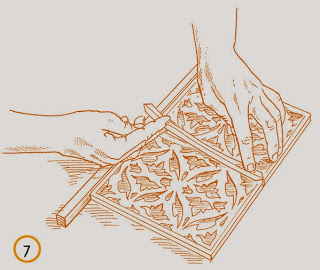
4. Unfold the two panels and place them face down on your work surface. Place another panel next to the set. Repeat step 3 to hinge the third panel to the second one, and then the fourth to the third.
5. When gluing the final hinge to complete the lantern, attach half of the hinge strip to one edge of the lantern (figure 8).
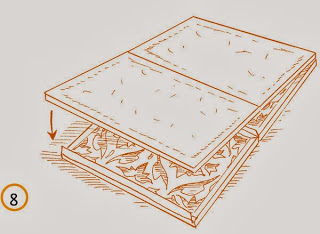
6. Carefully apply glue to the unattached edge of the hinge strip (take care not to get glue on any other part of the lantern) and fold the other unattached panel onto the strip, applying pressure to make sure that the hinge sticks to the final panel.
Variation: making a screen
If you prefer to make a folding screen instead of a lantern, you can use the same hinges for the lantern (see Making Hinges for a Lantern, above) and apply every other one to the opposite sides of the panels, so that the panels unfold like an accordion. Do not attach the end panels to each other so that the screen can remain open and can be viewed from both sides. Instructions for making a screen that turns inside out (referred to above) can be found in Paper Illuminated or the Shadow Lantern Kits.
Shadow lantern designs
You can vary the number of panels to create a triangular, pentagonal, or hexagonal lantern. You can also vary the shape of the panels. Since a screen is visible on both sides, you can also put the stencil on the front of the screen to accentuate the design rather than the shadow.


